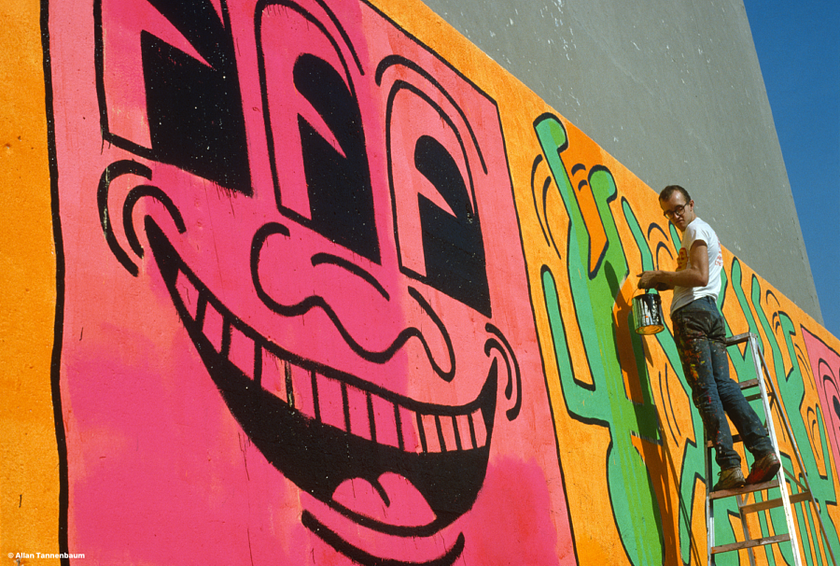KEITH HARING: RADIANT VISION
Long Beach Museum of Art
Long Beach
May 25 – Aug. 25, 2024
This Father’s Day was like any other Long Beach day as I strolled to the bluffs — the unhelpful shade of palms enabling the sun’s violence, the putrefaction of natural gas extraction drowning pockets of oxygen, and the absence of my own dad, 350 miles away, who avoids such liberal urban shitscapes as a matter of principle. I called him for the holiday on my walk to the cliff-top Craftsman mansions that comprise the stunning Long Beach Museum of Art complex, presiding over oily sand like a concerned patriarch.
LBMA is currently hosting the two-story showcase Radiant Vision, a collection of Keith Haring’s artworks, collaborative pieces, and related period memorabilia. It’s the second major Haring exhibition in Southern California in a year — more modest than the Broad’s thorough, awe-inspiring Art Is for Everybody last fall, but with surprisingly little overlap beyond the artist’s typical recurring symbols and iconic Free South Africa (1985) series.
Situated mere blocks from the Alamitos Beach gayborhood, LBMA provides an engaging location for Haring’s East Coast contributions to complement Southern California’s queer history, an environment where his loud, bouncy marker sketches are haunted by unrelenting toxic waves crashing outside.
In his short life, Haring played many roles: creative suburban art-school kid, following the tried-and-true path to becoming a serious painter; once-in-a-generation branding mastermind, as a mass-producer of idiosyncratic line-based hieroglyphs; 1980s Warhol protégé, sharing an East Village coterie with Jean-Michel Basquiat and Kenny Scharf; openly gay man in Gordon Gecko’s NYC, with pervasive public visibility during Reagan’s homo-cidal administration; and AIDS epidemic casualty, physically withering while still on an early-career ascent to pop-art canonization. Although Haring, as far as we know, remained childless his whole life, Radiant Vision urged me to consider a role for him that had never crossed my mind: nurturing father figure.
Many see the “Street Art Boy” as a populist Peter Pan who fixated on simplified doodles and was fascinated by cutting-edge music styles, celeb-studded parties, picture-books, and children’s playthings. Radiant Vision spotlighted touching snapshots of Haring the son — his feather-haired yearbook photos, his Apocalypse silkscreen project (1988) with (admittedly controversial) elder William S. Burroughs guiding the artist’s imagery through fucked-up prose. Haring’s boyish mischief shone through in his self-portraits and dollar defacements on display.
But as his own prowess grew, Haring was eager to gift his knowledge and resources to subsequent generations. His friendship with adolescent graffiti prodigy Angel “LA2” Ortiz begat prolific results; the Broad exhibit opened with some of their collaborative pieces to shed light on the two-way street of influence. LBMA, meanwhile, devoted Radiant Vision’s final room to Ortiz’s recent work, buttressed by floor-to-ceiling windows overlooking the Pacific and the din of beachgoing families. Ortiz’s chaotic arrays of lines, symbolic squiggles, and appropriations of objects-as-canvases reflected the Haring-tinged inspiration for these choice pieces, but with plenty of dynamics and chrome paint to mark them as distinctly LA2.
A major LBMA highlight was the discussion of Haring’s youth outreach, including collabs with up to 1,000 students for public murals in Chicago and New York, as well as his creation of new work for pediatric hospitals and community centers. He saw himself as “a good companion to a lot of children” and hoped to “have touched their lives in a way that will be passed on through time.” I saw an entire wall heartwarmingly devoted to a suite of surreal popes and twisted snakewomen, unhinged correspondence sketches between the artist and creative 10-year-old Tony Kalish, who befriended Haring through frequent Pop Shop visits.
Radiant Vision positioned Haring as the wholesome guide kids needed in an era of overwhelming fear, selfish individualism, and unreckoned-with loss; he “treated kids like Kalish as artistic peers and took their collaborations seriously,” one museum label read. Becoming the parent of innumerable “radiant babies” made him understand that it is “maybe as important to communicate to one person, one ten-year-old that’s growing up, as it is to try to make any big effect on the entire world.”
Happy Father’s Day, Keith Haring.






